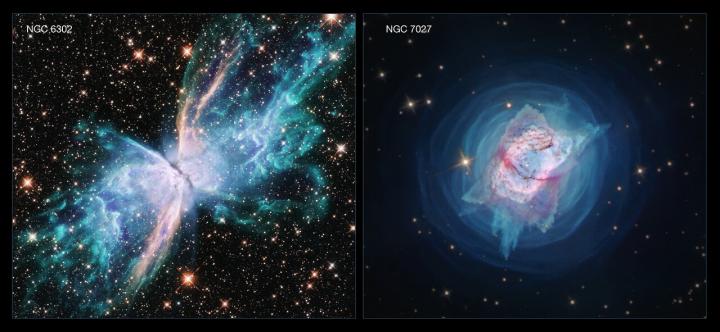
Credit: NASA, ESA, and J. Kastner (RIT)
The NASA/Hubble Space Telescope demonstrates its full range of imaging capabilities with two new images of planetary nebulae. The images depict two nearby young planetary nebulae, NGC 6302, dubbed the Butterfly Nebula, and NGC 7027. Both are among the dustiest planetary nebulae known and both contain unusually large masses of gas, which made them an interesting pair for study in parallel by a team of researchers.
As nuclear fusion engines, most stars live placid lives for hundreds of millions to billions of years. But near the end of their lives they can turn into crazy whirligigs, puffing off shells and jets of hot gas. Astronomers have used Hubble to dissect such crazy fireworks happening in these two planetary nebulae. The researchers have found unprecedented levels of complexity and rapid changes in the jets and gas bubbles blasting off of the stars at the center of each nebula [1]. Hubble is now allowing the researchers to converge on an understanding of the mechanisms underlying this chaos.
The Hubble Space Telescope has imaged these objects before, but not for many years and never before with the Wide Field Camera 3 instrument across its full wavelength range — making observations in near-ultraviolet to near-infrared light. “These new multi-wavelength Hubble observations provide the most comprehensive view to date of both of these spectacular nebulae,” said Joel Kastner of the Rochester Institute of Technology, Rochester, New York, leader of the new study. “As I was downloading the resulting images, I felt like a kid in a candy store.”
The new Hubble images reveal in vivid detail how both nebulae are splitting themselves apart on extremely short timescales — allowing astronomers to see changes over the past couple of decades. In particular, Hubble’s broad multi-wavelength views of each nebula are helping the researchers to trace the histories of shock waves in them. Such shocks are typically generated when fresh, fast stellar winds slam into and sweep up more slowly expanding gas and dust ejected by the star in its recent past, generating bubble-like cavities with well-defined walls.
Researchers suspect that at the heart of each nebula were two stars orbiting around each other. Evidence for such a central “dynamic duo” comes from the bizarre shapes of these nebulas. Each has a pinched, dusty waist and polar lobes or outflows, as well as other, more complex symmetrical patterns.
A leading theory for the generation of such structures in planetary nebulae is that the mass-losing star is one of two stars in a binary system. The two stars orbit one another closely enough that they eventually interact, producing a gas disc around one or both stars. The disc then launches jets that inflate polar-directed lobes of outflowing gas.
Another, related, popular hypothesis is that the smaller star of the pair may merge with its bloated, more rapidly evolving stellar companion. This very short-lived “common envelope” binary star configuration can also generate wobbling jets, forming the trademark bipolar outflows commonly seen in planetary nebulae. However, the suspect companion stars in these planetary nebulae have not been directly observed. Researchers suggest this may be because these companions are next to, or have already been swallowed by, far larger and brighter red giant stars.
NGC 6302, commonly known as the Butterfly Nebula, exhibits a distinct S-shaped pattern seen in reddish-orange in the image. Imagine a lawn sprinkler spinning wildly, throwing out two S-shaped streams. In this case it is not water in the air, but gas blown out at high speed by a star. And the “S” only appears when captured by the Hubble camera filter that records near-infrared emission from singly ionised iron atoms. This iron emission is indicative of energetic collisions between both slow and fast winds, which is most commonly observed in active galactic nuclei and supernova remnants.
“This is very rarely seen in planetary nebulae,” explained team member Bruce Balick of the University of Washington in Seattle. “Importantly, the iron emission image shows that fast, off-axis winds penetrate far into the nebula like tsunamis, obliterating former clumps in their paths and leaving only long tails of debris.”
The accompanying image of NGC 7027, which resembles a jewel bug, indicates that it had been slowly puffing away its mass in quiet, spherically symmetric or perhaps spiral patterns for centuries — until relatively recently. “Something recently went haywire at the very centre, producing a new cloverleaf pattern, with bullets of material shooting out in specific directions,” Kastner explained.
###
Notes
[1] The team’s paper, “First Results from a Panchromatic HST/WFC3 Imaging Study of the Young, Rapidly Evolving Planetary Nebulae NGC 7027 and NGC 6302” was published (https:/
More information
The Hubble Space Telescope is a project of international cooperation between ESA and NASA.
The team of astronomers who carried out this study consists of J. Kastner, J. Bublitz, B. Balick, P. Moraga, A. Frank, and E. Blackman.
These observations were conducted under the Hubble observation programme 15953.
Links
- Hubble’s Previous Observations of NGC 6302 – https:/
/ www. spacetelescope. org/ images/ ?search= NGC+6302 - Hubble’s Previous Observations of NGC 7027 – https:/
/ www. spacetelescope. org/ images/ ?search= NGC+7027 - Images of Hubble – http://www.
spacetelescope. org/ images/ archive/ category/ spacecraft/ - Hubblesite release – https:/
/ hubblesite. org/ contents/ news-releases/ 2020/ news-2020-31 - Science paper – https:/
/ www. mdpi. com/ 2075-4434/ 8/ 2/ 49
Contacts
Joel Kastner
Rochester Institute of Technology
New York, USA
Email: [email protected]
Bethany Downer
ESA/Hubble, Public Information Officer
Garching, Germany
Email: [email protected]
Media Contact
Bethany Downer
[email protected]
Original Source
http://www.




